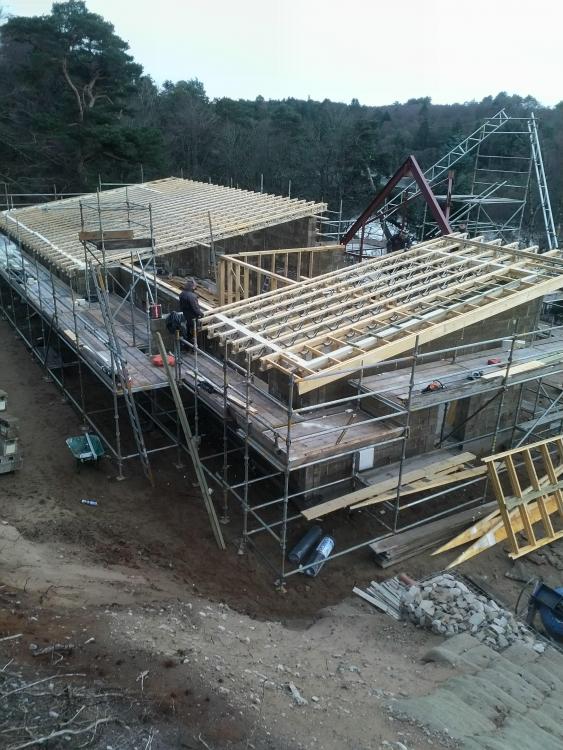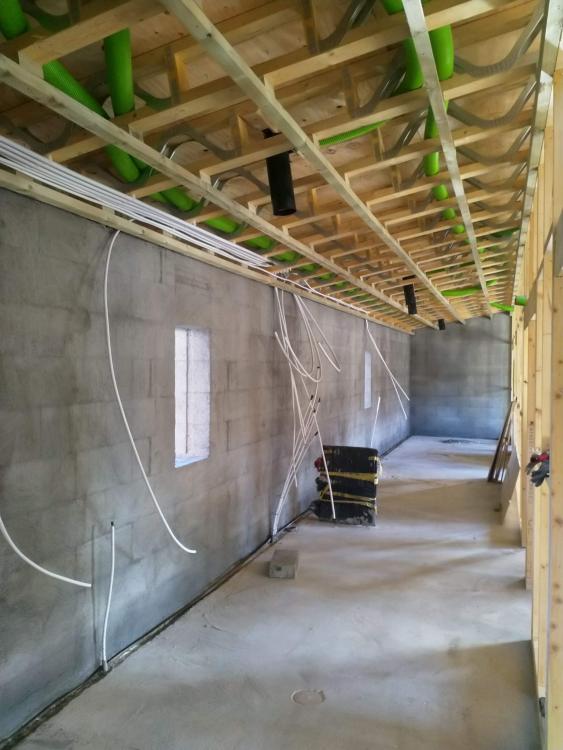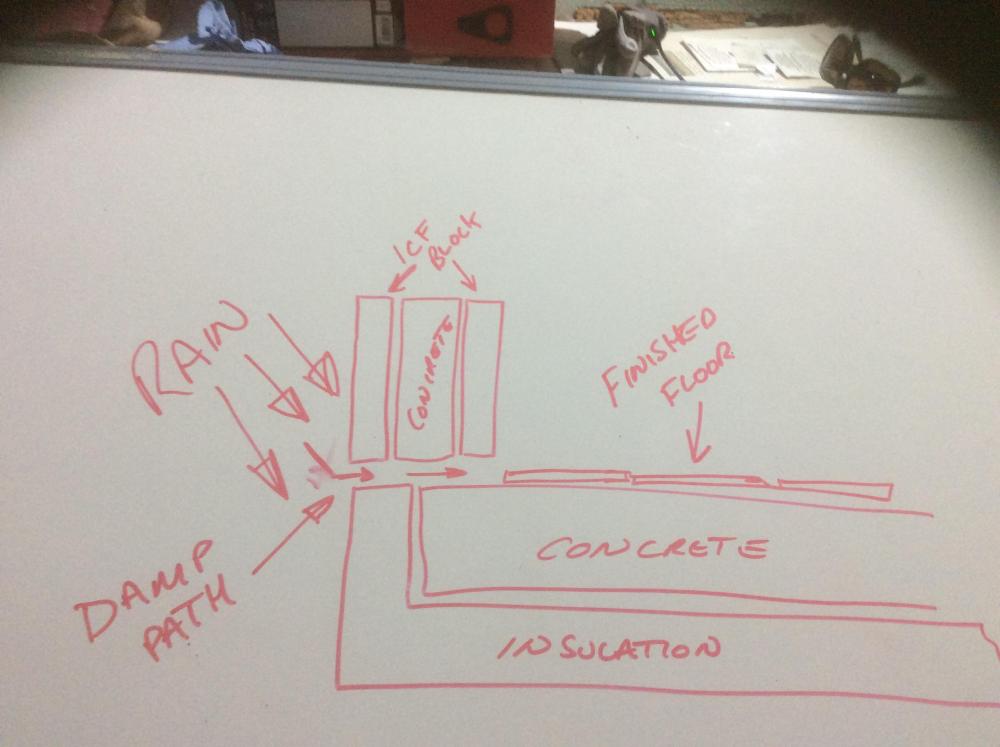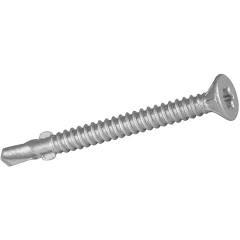Leaderboard
Popular Content
Showing content with the highest reputation on 01/11/22 in all areas
-
5kW monoblock ASHP driving wet under floor heating and a 300 litre unvented hot water tank. 3 bedroom 150 square metre 1 1/2 storey house. Well insulated and air tight to near passive house levels, calculated (and borne out with actual figures) worst case heat loss about 2.5kW I do have a room sealed wood burning stove as well. It will heat the whole house, or rather it MUST heat the whole house, shut the doors so the heat is confined to 1 room and that will very quickly overheat, it only works because the house layout allows the heat to travel to all rooms. It supliments the heating to use up free wood and reduce electricity usage, and as a backup in case of power cuts. And for those grey wet days when 20 degrees feels "cold" when it is dreary so we use it to crank things up a bit.2 points
-
Designer/draftman & structural engineer combo. Then managed on a subcontractor basis. Two joiners made the kits from the materials I ordered. I had never order any building materials before I started. You are here asking questions, just a lot to learn. We all did at some point! Home builder bible is a worthwhile investment for a tenner, provides a good breakdown of what is required to build a house. My approach was to get the site serviced (utility, water, access) and have a clear idea of what foundations would be required. I then knew that unexpected major costs were eliminated. See above on the book. I've kept a blog here. I kept mine going from the start to end and have tried to be open and honest with costs. But lots of others here if you are planning on other building styles.2 points
-
Our extension's foundations were poured in 2019. The blockwork was completed in 2020 with floor screed and wet plaster finished in April that year. It went all through the summer of 2020, and 2021 - by the end of which RH levels were still up as high as 80%. I got fed up and bought a dehumidifier which has been running constantly ever since xmas. 3 Litres a day is still coming out. But outdoor humidity is currently in the 90's so I don't know if its a massive air leak or just still drying out. I think the latter because the attached garage does occasionally drop below 70% So yes, there's a stupid amount if water in the fabric of new buildings and it sticks around for years.1 point
-
Another option would Posi rafters. These are pre made in a factory, which cuts site time down, ours are approx 9m long. Our flat roofs were ready for boarding over in two days. Used the gaps for running mvhr etc We then under draw with 50mm Short battens, then counter battened with a further 50mm, to give a 350mm cavity, this was then spray foamed.1 point
-
If you Google - How long does for a house to dry put - the first answer from the NHBC is 18-24 months to get fully dried out. I didn't really track it in my house, but thE RH nowadays is much lower than was in the first year. Considering the low heat input you have, the house could easily take over a year to fully dry out and will have more humidity than normal until then. The dehumidifier is the answer. I also suspect that running your heating at 21-22C will dry it out much faster as it would considerably increase the differential between outside and inside and increase how long the heating runs for. It would also warm the windows up more and stop the condensation in the mean time.1 point
-
This was a common enough roof structure back in the day., when times were tight and standards were more of wing and a prayer affair. 3x 2 ceiling joist spanning what looks like say 12’, while also taking the load from struts to rafters lol. You wouldn’t dream of it now. It isn’t likely to fall down just deform more and more over many years. The struts were supposed to go close to a wall but this was poorly interpreted at times as we see. To sort it proper would be expensive ie steel purlins (shims to rafters) with hangers and runners to support the ceilings. I don’t think it practicable to reverse the deformation in rafters but ceiling joists should be quite doable. Then with the addition of hanger & runner the existing ceiling joist spans should be reasonable. I would guess this will be the engineers solution. An alternative would be to fabricate a deep timber lattice beam including the hangers and faced with ply sheeting. Engineers might shy away from this as it would require more structural design on their part but may be my preferred choice.1 point
-
In our previous house we had a gasifying log boiler with a large thermal store and lots of solar thermal collectors. If run hot with dry wood, as it should be, it doesn't create much pollution and presumably you don't have near neighbors to annoy. (Unlike all the houses near us who all have gas ch but still burn wet wood and coal and create lots of pollution.) However in a new well insulated house (as it should be if it's a new build) it's a bad idea. It will be expensive to install, messy to run and stands a good chance of over heating the house. Solar thermal and PV are useless for heat in the winter especially in the north. ASHP is a much better option if you can get it designed and configured correctly. I wouldn't take a sample of one as a guide. Various contributors here have ASHPs which apparently work well, but the system must be properly designed.1 point
-
I also have a leak from a Vent Axia Kinetic Plus, water trickles out from the front and sometimes from the back of the case. Drain pipe and trap appear to be clear. The problem seems to stem from the poor design of the the cell/unit in respect of condensed water; it just has to find its way out of the cell, past the summer bypass and down the drain. There is a slight fall on the foam insulation that the bypass mechanism sits on but nowhere near enough to ensure water runs into the centre of the unit and then down the drain. With high levels of moisture and cold weather I e. winter, water just spills out in all directions! I think a proper solution would require modifications to the cell and the summer bypass to provide a decent route for water, in the meantime removing the summer bypass unit in winter solves the problem (making sure to insulate the 2 power connectors).1 point
-
@dpmiller whilst it’s not been properly commissioned it supplies where it should supply and extracts where it should extract. What I don’t know is if it is supplying and extracting the amount of air it should be.1 point
-
I have a major issue with icf onto an insulated slab, having built a house on a raft foundation we included a step at the edge, but seeing first hand how these are being built at the moment I really do not like the method of the flat slab with the icf sitting directly on the slab. There is a direct route for moisture to pass into the building at floor level. see rough sketch. @IanMcP you need to be a bit careful using Nudura standard details, as it’s all a bit Canadian and needs adapting to suit your site.1 point
-
Your ward councillor is allowed to support you, but may have to abstain (depends on the council's own rules, which she likely doesn't know). Not wanting to is a downer. So, you are supposedly entitled to a councillor's help and yours refuses so, yes, ask the next one. If they don't agree with your proposal then that is another matter.1 point
-
Pound for pound an uninsulated slab/raft and a high performance wall will give you more benefit than an insulated raft and high performing walls. A correct sap assessment using supplier details rather than standard shows u values of walls isn't the be all and end all and a normal raft can be protected to afford some of the insulated raft benefits. Based on experience from 40+ units of various designs.1 point
-
Sometimes there are other clues such as front wall and gate positions, and old fences down the back garden. Look, kind neighbour, the boundary goes from here to there and the fence is wrong, but hey I wont make you move it and you allow my gutters.1 point
-
If I haven't explained properly, tell me and I will try again. But I would do 2 things. 1. If you have graphics of how little this will affect the street scene/ neighbour, ask the planning officer to display it during your presentation. Just one definitive picture, not a slide show. 2. Lobby your own councillor as they have by far the most credibility. Give them a precis and pictures that make it easy for them to understand and explain. They can talk almost as long as they like. They will also ask another councillor to support the motion. I remember the last time I did this, the supporting councillor simply said ' I know the village and the passion of the parish council, and if they say that this will spoil the village then I support them.' and sat down. The rest of the councillors will tend to go along with that proposal, as they don't care much, but will want similar help themselves some time. If it goes your way, the planner then agrees a form of words on the spot.1 point
-
I am only familiar with two cases and doubt I can add value above what your planning consultant is advising. In one case the self builder represented himself at committee and won. The pro planner from the council department could not present a rational case for the initial refusal and was subtly admonished for wasting the committee's time. The self builder was mostly peeved about the additional £1500 cost of printing an info folio for each committee member to refer to. The second case of two properties about 50 metres apart. The one inside the conservation area was subject to fine grain conditions about finishing materials to created a heritage look and the other effectively in the same village just outside the CA boundary is a leading edge passiv house with a green roof, acres of glazing and PV. Planners just seem to have segmented minds and either try to apply rules or they roll a dice.1 point
-
This was in England so I am only answering re England. Having spoken in several planning meetings on behalf of a client or the Parish I can only answer re those Borough or District councils I have been involved with. (I have attended many more meetings as an observer and heard the process) There is only 3 minutes to speak, therefore you are making it clear to the councillors who have not read the documents (they haven't) that the case is good. When speaking for the parish, you are effectively speaking for many people. If we weren't making this statement it would look as if we didn't care. However the main point is that it is before the committee because we asked for it to be, and it is essential that a councillor proposes acceptance/rejection on your behalf. I have often heard it said that councils/ enquiries take the presence of locals as a given, and a lack of attendance shows that they don't care enough. In summary the Parish Council has a say, but it is not a given and they have to support with evidence, not just vague statements.1 point
-
Well if you want to do as little as possible structurally I would just screw and glue 4x2 alongside the existing 3x2, level on the bottom at the lowest point and level across the room in both directions, no point in fixing to walls etc . Do this on every one, will strengthen them a lot and give you a flat surface to plasterboard too.1 point
-
I didn’t edit it out, like I didn’t edit out the rest of your piece, I quoted the relevant part, I just wanted to make my point that planners don’t always act fairly!1 point
-
I know, why did you edit out my "when playing fair" prefix?1 point
-
Your need to do your research because my understanding of planning committee hearings that you will be timeboxed to a few minutes to present your case. You don't want to be blindsided when the committee chair refers to the pro planner who says something like "May I remind the committee of section (f) in the 2016 revisions introduced to curtail the random distribution of new upmarket mansions in the upper Xxxx valley".1 point
-
Not in my case, when I went to appeal and won the council were told in no uncertain terms that they were not abiding by their own policies. After 3 planning applications we applied fir something we did not want but would pass planning. The ground floor was exactly the same, just upstairs was different. This allowed for digging and foundations etc to start, we then appealed planning application non1 (which was what we really wanted) and won, so by the time the builder got to first floor level I had new plans for him. I would not pay planners in washers, they even told me that if I appealed I would more than lightly win, go figure.1 point
-
You deserve a direct conversation with them, their objection might be ridge height or the position of the garage. Who knows. Since buying my plot I have had extensive (literally hours in total) free face to face and telephone conversations with my local district planning department, all for the price of one £230 NMA. There is no parity of access to planners across the country judging by many accounts here. How long ago did your neighbour obtain planning? I ask because when playing fair planners try to stick to their rule book and the most recent incarnation of published planning policy. The local planning policy will be revised over time.1 point
-
All of them or you will have too big a spacing for fixing PB then will end up with sagging plasterboard! You are beginning to sound like a contractor trying to cut costs at every turn! ?1 point
-
Should be able to do it yourself with a hired meter. Was the system designed for you by the supplier? If so, they should be able to give you the design air flow rates for each terminal. That won't be helping IMO. Air will take the easiest route, so you need to restrict the 'easy' routes to force air through the longer, bendier ducts, otherwise the route of air flow through the house as a whole won't be as intended.1 point
-
The Vaillant controller also uses degree-minutes (by default compressor starts at -60°, stops at 0°) to regulate flow temperature and really comes in to effect when the ASHP minimum output is greater than the demand, i.e. the set point cannot be maintained and the ASHP over-shoots. In this case, the heat pump cycles around the set point using the degree-minutes metric to average out the flow temperature to the set point over time. This is all done under the control of the heat pump interface, which is a box of electronics that also controls three-port valve, circulation pumps, immersions etc. Separately, the Vaillant system uses another device - VR700, VR700f, or SensoComfort - which is a room-stat and programmer which is cited somewhere in the living space because it includes a room temperature sensor. It computes the desired flow temperature based on outside temperature, inside temperature, set-point, configured curve, and min/max thresholds, and sends the required temperature to the heat pump controller, which deals with running the ASHP itself. In relation to the COPs, run-time and curves: the VR700 (etc) will reduce the flow temperature as the room temperature is exceeded (and vice-versa) by shifting the curve up and down (actually 45° according to the manual). It can also self-tune the curve over time but the curve needs to be approximately right in the first place for it to do so. The original point I was making is that the curve setting (or max/min temps on other controllers) aren't just dependent on the property but also on the number of hours per day that the heating is used and can be adjusted accordingly. Sorry for the confusion.1 point
-
Received wisdom on this forum is that Parish Councils have very little influence on planning decisions, the usual context of such discussions is an objection from the PC. By implication their support does not count for much. Your design is rather large, it looks over 3000 sq ft of internal floor space. When you made a comparison with your existing bungalow was that based on ground foot print or livable internal floor space?1 point
-
1 point
-
@Adsibob I installed them but overlooked the measuring of duct lengths that I’d installed. When it was finally all ready to be turned on (long after the ducts had been installed) I used a vacuumed cleaner to suck a bit of foam tied to a length of string down each duct (worked brilliantly) and then measured how much string zipped down each duct. They definitely all go where I think they go.1 point
-
Maybe take a marble and put it in each duct at the MVHR room, one duct at a time, and see where the marble goes (assuming the ducts all go down from the MVHR room (which applies to most of my ducts, but may not apply to yours) just to make sure the ducts are going where you think they are. For the ones that go upwards, i guess you put the marble at the other end, or throw up a tennis ball? Alternatively, a very long pipe cleaner.1 point
-
@MJNewton Thanks for updated the thread, good to hear that the roof is performing as it should!1 point
-
Be VERY careful, that voltage will kill you and what's worse it will bloody well hurt all the time you are dying. You normally leave at least one panel unplugged so the string is not completed until you have done ALL the DC wiring. Go and unplug one panel off each string before you do any more. As above 4mm or 6mm cable will be fine, make sure what you buy is sold as DC solar PV cable with a voltage rating of at least 1000V it is available in red and black colours.1 point
-
In the process of doing it... Blindspace header boxes and side channels are in. Installer has spec'd 5 core flex to each blind, Loxone Relay Extension will do the work in the cabinet. Only detail on blinds I've been told so far is chose ones with 240v motors.1 point
-
I have, ten years ago, both lots operate via zero volt contacts soldered into the buttons of the controllers effectively pushing the buttons automatically- still working, must remember to change the batteries in the two that ratio control the curtains again1 point
-
Haynes Self Build Manual is not a bad place to start. Then start researching details on here and other on line resources.1 point
-
1 point
-
We did exactly this and used loads of them. Advice is to pre drill with a 3 or 4 mm bit as it helps these go in really easy1 point
-
1 point
-
My battery setup is in an unheated and poorly insulated workshop. I found the heat generated from the batteries soon dissipated and the temp dropped. Since putting a crude cabinet around the batteries (mid December) the average temp is 15°C, workshop temp approximately 5°C. At this time of year I charge the batteries from the grid at night. Hope this helps. David1 point
-
Worth a search of BuildHub for "node red" (in quotes). It's been discussed before a few times.1 point
-
NodeRED uses connect-the-block pre defined modules to implement control. Lots of YouTube videos on it. You can do complex stuff in JavaScript which is pretty straightforward if you've ever done any programming.1 point
-
I can't believe this was three years ago now! Only feels like yesterday (I suppose the pandemic probably has something to do with that). With the multi-faceted issues it all got rather complicated and so with my ever-sensible father (whose OCD, obsession with details, bad luck when it comes to trademen etc all come from!) I went on to explore what the best solution would be best. The technical director of the firm that supplied the Desmopol (they supply all sorts of roofing products, they're not the manufacturer) and he was the one person that I found supremely knowledgeable on all things roofing and, most importantly, completely trustworthy. A decent bloke and so one I decided to put my trust in. He suggested that ripping the whole roof and starting again might not be as perfect a solution as one might hope given the inevitable disruption to the rest of the construction, particularly if done by a fuming builder! Furthermore, he said he's spent his life up on roofs and so can spot a roof that will leak vs one that won't and he was absolutely confident that mine was of the latter. He assured me that the usual issues that plague too-flat flat roofs wouldn't apply here given how small it was and that the Desmopol product was approved for zero-falls application anyway (the BBE certificate I had said it wasn't but it turns out that was out of the date - there was a more uptodate one than confirmed its suitability). So, I started to accept the flatness issue as more a case of less-than-perfect work that you get from many a tradesman and regarding the Desmopol application itself he and I end up recoating it together. His company paid for the products and we both spent the morning on the roof recoating it. He does actually run the training courses for this and other products and so was going to invite me along to one of them but that'd leave me doing it all myself which whilst I wasn't too concerned about I think he wanted to help a bit more than that whilst also ensuring that the issue was definitely concluded. In a way I'm glad I got the chance to reapply with his help as in 10/15 years time when I should be recoated I'll be confident knowing how easy it is. So that's what we did and, three years on and - touch wood - we haven't had any leaks or anything and I think something would've happened by now. After a rain shower the roof drains in the same way every time with a little bit of pooling in one area, but that's stretching the term I think as it usually evaporates fairly quickly. It still haunts me a little whenever I see it and that happens often as my daughter's bedroom overlooks it! If it wasn't overlooked I'd probably have forgotten all about it by now I'm sure.1 point
-
You can only demand costs if you can prove the planners broke the rules, not abiding by their own policies even is not enough to ask fir costs (ask me how I know). I would get someone to do a “street view”, mine was done by an architect who did a pen sketch of the outline of the house, hedges, trees and neighbours to show the actual impact. This helped a lot with the appeal.1 point
-
Call your local Councillor and see if you can get it called in to Committee. It is a great looking scheme.1 point
-
It's always subjective because the policies are written in such an ambiguous way that the planners can use them as they want. The Head of Planning told me one Planning Officer might refuse an application and another officer in the same office permit it. We went to the Planning Committee and won unanimously much to the planners annoyance. The planners themselves told me they didn't have anyone with design qualifications and asked the Conservation Officer to look at my application.1 point
-
I would go straight to appeal and not waste any time with the local planners. And ask for costs as their decision looks to be meritless on what you have shared. Bloody planners.1 point
-
"The proposed replacement dwelling, by reason of its scale and mass, would harm the character and appearance of the area". Is this the only reason for refusal on the decision notice, if so it is purely subjective? Or is there anything else cited ? I asked because our initial application was refused for character and greenbelt reasons. Once we were confident on the greenbelt element for the refusal could be overcome that left us to deal with the landscape and character issue. It would appear no absolute planning policy has been breached but rather it doesn't suit the opinion of the planning officer. A superior authority, ie an inspector could come to a different opinion if well reasoned. A landscape visual impact assessment my help........it certainly did with our appeal, an expert could demonstrate in detail why it is acceptable in landscape and visual amenity terms.1 point
-
Good to hear some experience. I've not done the install yet, we've been playing with samples to decide on the colour, a task in itself! I've also been talking to suppliers re recommended substrates and like with everything there seems to be rather differing opinions. One supplier of a major Spanish microcement manufacturer has said I can simply use plasterboard with skim as the microcement is waterproof, but I have to say I'm a bit wary of that in a shower enclosure. I'm going to use Knauf Exterior Aquapanel as the substrate instead. The buildup has also been an interesting task in research as different makes have slightly different approaches. Some do use 2-part resin mixed coats and then also waterproof coating, some use one-part base and middle coat with a couple of layers of waterproof coating with different hardeners. Some suggest a reinforcing mesh within the shower walls, some don't. I need a little time to figure this out and make a decision that isn't self-builder overkill yet remains robust. Since there hasn't been any other input, I'll assume it's not got much traction here and will report back once I've taken the plunge, hopefully before Xmas if I'm lucky.1 point
-
That was going to be my default position but the damn things backed me into a corner, I've got a patio to do, I don't have time for this niff-naff and trivia! Plus work want me to 'work'! There's not enough hours in the day.0 points
This leaderboard is set to London/GMT+01:00
















.jpg.c21f3ac78c9b7efd90cbdcb312744dc5.thumb.jpg.7adcad4c0e384f5ecd7d56b0618df6e5.jpg)

